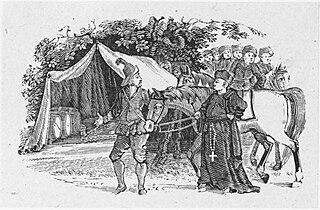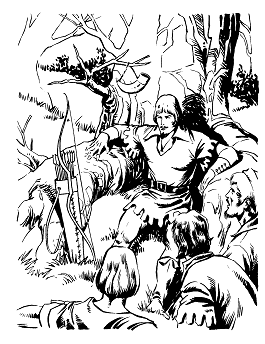
Robin Hood is a legendary heroic outlaw originally depicted in English folklore and subsequently featured in literature, theatre, and cinema. According to legend, he was a highly skilled archer and swordsman. In some versions of the legend, he is depicted as being of noble birth, and in modern retellings he is sometimes depicted as having fought in the Crusades before returning to England to find his lands taken by the Sheriff. In the oldest known versions, he is instead a member of the yeoman class. He is traditionally depicted dressed in Lincoln green. Today, he is most closely associated with his stance of "robbing the rich to give to the poor".

Little John is a companion of Robin Hood who serves as his chief lieutenant and second-in-command of the Merry Men. He is one of only a handful of consistently named characters who relate to Robin Hood and one of the two oldest Merry Men, alongside Much the Miller's Son. His name is an ironic reference to his giant frame, as he is usually portrayed in legend as a huge warrior – a 7-foot-tall (2.1-metre) master of the quarterstaff. In folklore, he fought Robin Hood on a tree bridge across a river on their first meeting.

Maid Marian is the heroine of the Robin Hood legend in English folklore, often taken to be his lover. She is not mentioned in the early, medieval versions of the legend, but was the subject of at least two plays by 1600. Her history and circumstances are obscure, but she commanded high respect in Robin’s circle for her courage and independence as well as her beauty and loyalty. For this reason, she is celebrated by feminist commentators as one of the early strong female characters in English literature.
The Percy Folio is a folio book of English ballads used by Thomas Percy to compile his Reliques of Ancient Poetry. Although the manuscript itself was compiled in the 17th century, some of its material goes back well into the 12th century. It was the most important of the source documents used by Francis James Child for his 1883 collection The English and Scottish Popular Ballads.
The Bishop of Hereford is a character in the Robin Hood legend. He is typically portrayed as a wealthy and greedy clergyman who is robbed by Robin and his Merry Men.
Will Scarlet is a prominent member of Robin Hood's Merry Men. He is present in the earliest ballads along with Little John and Much the Miller's Son.
Richard at the Lee is a major character in the early medieval ballads of Robin Hood, especially the lengthy ballad A Gest of Robyn Hode, and has reappeared in Robin Hood tales throughout the centuries.
Robin Hood Rescuing Three Squires or Robin Hood and the Widow's Three Sons is a traditional ballad about Robin Hood, listed as Child ballad 140 and Roud 70.

Robin Hood and the Potter is a 15th century ballad of Robin Hood. While usually classed with other Robin Hood ballads, it does not appear to have originally been intended to be sung, but rather recited by a minstrel, and thus is closer to a poem. It is one of the very oldest pieces of the surviving Robin Hood legend, with perhaps only Robin Hood and the Monk older than it. It inspired a short play intended for use in May Day games, attested to around 1560. It was later published by Francis James Child as Child ballad #121 in his influential collection of popular ballads in the 1880s.
Robin Hood and the Butcher is a story in the Robin Hood canon which has survived as, among other forms, a late seventeenth-century English broadside ballad, and is one of several ballads about the medieval folk hero that form part of the Child ballad collection, which is one of the most comprehensive collections of traditional English ballads. It may have been derived from the similar Robin Hood and the Potter.
"Robin Hood and the Golden Arrow" is an English folk song, part of the Robin Hood canon. It features an archery competition for a golden arrow that has long appeared in Robin Hood tales, but it is the oldest recorded one where Robin's disguise prevents his detection.
Robin Hood's Delight is an English folk song. It is a story in the Robin Hood canon which has survived as, among other forms, a late seventeenth-century English broadside ballad, and is one of several ballads about the medieval folk hero that form part of the Child ballad collection, which is one of the most comprehensive collections of traditional English ballads.

The King's Disguise, and Friendship with Robin Hood is an English ballad of Robin Hood. It is a relatively late work in the corpus, found in the Forresters Manuscript from the 1670s. The work seems loosely based on the 7th and 8th fyttes of A Gest of Robyn Hode which recounts the end of Robin Hood's outlawry after an encounter with the king. Unlike Gest, the king is not acting out of the need to suppress Robin; additionally, The King's Disguise and Friendship uses the 17th century updates to the legend that places Robin as contemporaneous with King Richard's reign. In the late 1800s, Francis James Child included it in his influential collection, the Child Ballads, as #151.

A Gest of Robyn Hode is one of the earliest surviving texts of the Robin Hood tales. Written in late Middle English poetic verse, it is an early example of an English language ballad, in which the verses are grouped in quatrains with an ABCB rhyme scheme, also known as ballad stanzas. Gest, which means tale or adventure, is a compilation of various Robin Hood tales, arranged as a sequence of adventures involving the yeoman outlaws Robin Hood and Little John, the poor knight Sir Richard at the Lee, the greedy abbot of St Mary's Abbey, the villainous Sheriff of Nottingham, and King Edward of England. The work survives in printed editions from the early 16th century, just some 30 years after the first printing press was brought to England. Its popularity is proven by the fact that portions of more than ten 16th- and 17th-century printed editions have been preserved. While the oldest surviving copies are from the early 16th century, many scholars believe that based on the style of writing, the work likely dates to the 15th century, perhaps even as early as 1400. The story itself is set somewhere from 1272 to 1483, during the reign of a King Edward; this contrasts with later works, which generally placed Robin Hood earlier in 1189–1216, during the reigns of Richard I of England and John, King of England.
"Robin Hood's Birth, Breeding, Valor, and Marriage" is an English folk song. It recounts Robin Hood's adventures hunting and a romance with Clorinda, the queen of the shepherdesses, a heroine who did not prove able to displace Maid Marian as his sweetheart.
A True Tale of Robin Hood is an English folk song, featuring Robin Hood and, indeed, presents a full account of his life, from before his becoming an outlaw, to his death. It describes him as the Earl of Huntington, which is a fairly late development in the ballads. It definitively places him in Richard the Lionhearted's reign.

Robin Hood and the Monk is a Middle English ballad and one of the oldest surviving ballads of Robin Hood. The earliest surviving document with the work is from around 1450, and it may have been composed even earlier in the 15th century. It is also one of the longest ballads at around 2,700 words. It is considered one of the best of the original ballads of Robin Hood.
"Robin Hood and the Beggar" is a story in the Robin Hood canon which has survived as, among other forms, a late seventeenth-century English broadside ballad, and is a pair out of several ballads about the medieval folk hero that form part of the Child ballad collection, which is one of the most comprehensive collections of traditional English ballads. These two ballads share the same basic plot device in which the English folk hero Robin Hood meets a beggar.

The Merry Men are the group of outlaws who follow Robin Hood in English literature and folklore. The group appears in the earliest ballads about Robin Hood and remains popular in modern adaptations.

A Challenge for Robin Hood is a 1967 British adventure film directed by C. M. Pennington-Richards and starring Barrie Ingham, Peter Blythe and John Arnatt.








